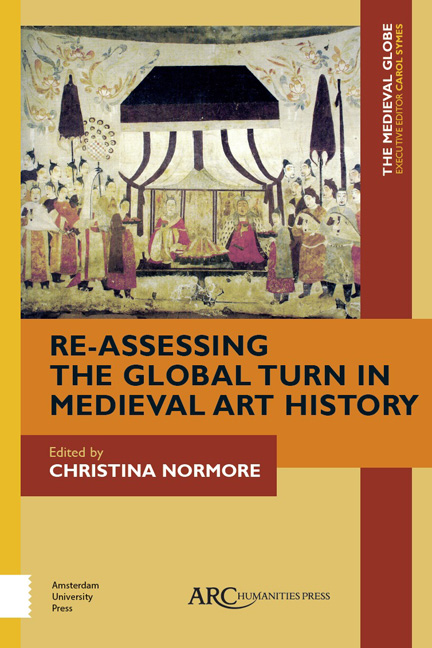Book contents
- Frontmatter
- Contents
- List of Illustrations
- Editor’s Introduction: A World within Worlds? Reassessing the Global Turn in Medieval Art History
- A Camel’s Pace: A Cautionary Global
- The Fatimid Holy City: Rebuilding Jerusalem in the Eleventh Century
- Worldliness in Byzantium and Beyond: Reassessing the Visual Networks of Barlaam and Ioasaph
- Exchange of Sacrifices: West Africa in the Medieval World of Goods
- The Beryozovo Cup: A Byzantine Object at the Crossroads of TwelfthCentury Eurasia
- Mobile Meanings: A Global Approach to a Dagger from Greater Syria
- Global Medieval at the “End of the Silk Road,” circa 756 CE: The Shōsō-in Collection in Japan
- Response: Medievalists and Early Modernists—A World Divided?
- Index
Editor’s Introduction: A World within Worlds? Reassessing the Global Turn in Medieval Art History
Published online by Cambridge University Press: 23 January 2021
- Frontmatter
- Contents
- List of Illustrations
- Editor’s Introduction: A World within Worlds? Reassessing the Global Turn in Medieval Art History
- A Camel’s Pace: A Cautionary Global
- The Fatimid Holy City: Rebuilding Jerusalem in the Eleventh Century
- Worldliness in Byzantium and Beyond: Reassessing the Visual Networks of Barlaam and Ioasaph
- Exchange of Sacrifices: West Africa in the Medieval World of Goods
- The Beryozovo Cup: A Byzantine Object at the Crossroads of TwelfthCentury Eurasia
- Mobile Meanings: A Global Approach to a Dagger from Greater Syria
- Global Medieval at the “End of the Silk Road,” circa 756 CE: The Shōsō-in Collection in Japan
- Response: Medievalists and Early Modernists—A World Divided?
- Index
Summary
If you would search [this volume] diligently, you will discover within it whatsoever kinds and mixtures of diverse colors Greece has; whatsoever techniques in enamel or varieties of niello Rus’ knows; whatsoever work Arabia distinguishes by hammering, casting or intaglio; whatsoever of diverse vessels or gems or bones Italy adorns by sculpture with gold; whatsoever France loves in its precious variety of windows; whatsoever fine work ingenious Germany praises in gold, silver, copper, iron, woods and stones.
LIKELY WRITING FROM within the monastic walls of a Benedictine monastery in the Rhineland, the early twelfthcentury author who chose to be known by the Greek pseudonym Theophilus imagined a world of art that was simultaneously distant and close to hand.Geographically, he ranges from the Ukraine to Italy, France to the eastern Mediterranean; materially, he moves from wood to gold, bone to stained glass. Each region has its specialties, which differ from each other in kind, but not in quality. At the same time, Theophilus shows no interest in traversing the distances between these varied areas, understanding their differing ways or even collecting their signature products. Earlier in his prologue, he urges his reader to value things according to their merits rather than their pedigrees, and to prefer the local whenever possible: “If common vines were to produce myrrh, frankincense, and balsam for you … is it possible that you would despise them as cheap and homely, and travel lands and seas to procure foreign things that are not better but possibly worse? This you would judge to be great stupidity.”
Rather than indulge in such silliness, Theophilus suggests, the reader would be better off reading and implementing his own technical synthesis, conveniently located close to hand in the text that follows. His seemingly global interests are, ultimately, mustered in service of highly local claims to importance and expertise.
The mixed messages within Theophilus's prologue find echoes in the ways that art historians account for his world and its arts today. As one of the few surviving twelfthcentury treatises on art making, Theophilus's text is a familiar source to most specialists in what is usually called, with any geographic qualifiers, medieval art history: that is, scholarship focused on Europe in the years stretching from the collapse of the Roman Empire to the late fifteenth century.
- Type
- Chapter
- Information
- Re-Assessing the Global Turn in Medieval Art History , pp. 1 - 10Publisher: Amsterdam University PressPrint publication year: 2018



